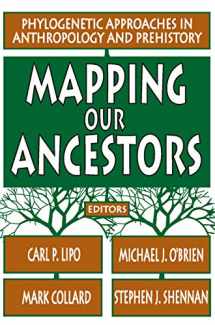
Mapping Our Ancestors: Phylogenetic Methods in Anthropology and Prehistory
ISBN-13:
9780202307510
ISBN-10:
0202307514
Edition:
1
Author:
Stephen Shennan, Mark Collard, Michael J. OBrien, Carl P. Lipo
Publication date:
2005
Publisher:
Routledge
Format:
Paperback
372 pages
Category:
Jewish
,
World History
,
Biology
,
Biological Sciences
,
Evolution
,
Anthropology
,
Behavioral Sciences
FREE US shipping
Book details
ISBN-13:
9780202307510
ISBN-10:
0202307514
Edition:
1
Author:
Stephen Shennan, Mark Collard, Michael J. OBrien, Carl P. Lipo
Publication date:
2005
Publisher:
Routledge
Format:
Paperback
372 pages
Category:
Jewish
,
World History
,
Biology
,
Biological Sciences
,
Evolution
,
Anthropology
,
Behavioral Sciences
Summary
Mapping Our Ancestors: Phylogenetic Methods in Anthropology and Prehistory (ISBN-13: 9780202307510 and ISBN-10: 0202307514), written by authors
Stephen Shennan, Mark Collard, Michael J. OBrien, Carl P. Lipo, was published by Routledge in 2005.
With an overall rating of 3.7 stars, it's a notable title among other
Jewish
(World History, Biology, Biological Sciences, Evolution, Anthropology, Behavioral Sciences) books. You can easily purchase or rent Mapping Our Ancestors: Phylogenetic Methods in Anthropology and Prehistory (Paperback) from BooksRun,
along with many other new and used
Jewish
books
and textbooks.
And, if you're looking to sell your copy, our current buyback offer is $0.3.
Description
Much of what we are comes from our ancestors. Through cultural and biological inheritance mechanisms, our genetic composition, instructions for constructing artifacts, the structure and content of languages, and rules for behavior are passed from parents to children and from individual to individual. Mapping Our Ancestors demonstrates how various genealogical or "phylogenetic" methods can be used both to answer questions about human history and to build evolutionary explanations for the shape of history. Anthropologists are increasingly turning to quantitative phylogenetic methods. These methods depend on the transmission of information regardless of mode and as such are applicable to many anthropological questions. In this way, phylogenetic approaches have the potential for building bridges among the various subdisciplines of anthropology; an exciting prospect indeed. The structure of Mapping Our Ancestors reflects the editors' goal of developing a common understanding of the methods and conditions under which ancestral relations can be derived in a range of data classes of interest to anthropologists. Specifically, this volume explores the degree to which patterns of ancestry can be determined from artifactual, genetic, linguistic, and behavioral data and how processes such as selection, transmission, and geography impact the results of phylogenetic analyses. Mapping Our Ancestors provides a solid demonstration of the potential of phylogenetic methods for studying the evolutionary history of human populations using a variety of data sources and thus helps explain how cultural material, language, and biology came to be as they are.


We would LOVE it if you could help us and other readers by reviewing the book
Book review

Congratulations! We have received your book review.
{user}
{createdAt}
by {truncated_author}


